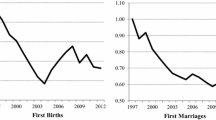Summary
This paper utilizes data from the 1986 Family Formation Survey of the ABS to examine the incidence and correlates of divorce among real cohorts of Australian women with specific characteristics. It is shown that marriage cohort, age at marriage, country of birth, area of residence, age left school and fertility status at marriage are related to the risk of divorce. The results of the present investigation complement findings of other studies on divorce in Australia as well as hazard model based studies from the USA, Canada and New Zealand.
Similar content being viewed by others
References
ALLISON, P.D. (1984),Event History Analysis, Sage, Beverly Hills.
AUSTRALIAN BUREAU OF STATISTICS (1988a),Year Book Australia 1988, Cat.3220.0, Australian Bureau of Statistics, Canberra.
AUSTRALIAN BUREAU OF STATISTICS (1988b),Divorces Australia 1987, Cat.3307.0, Australian Bureau of Statistics, Canberra.
AUSTRALIAN BUREAU OF STATISTICS (1989),Cross-classified Characteristics of Persons and Dwellings Australia, Australian Bureau of Statistics, Canberra.
BALAKRISHNAN, T.R., RAO, K., LAPIERRE-ADAMCYK, E. and KROTKI, K.J. (1987), “A hazard model analysis of the covariates of marriage dissolution in Canada”,Demography, 24: 395–406.
CARMICHAEL, G. (1988), “Socio-demographic correlates of divorce in New Zealand”,Journal of the Australian Population Association, 5: 58–81.
CARMICHAEL, G. and MCDONALD, P.F. (1986), “The rise and fall of divorce in Australia 1968-rd1986”, Paper presented at the Annual Meetings of the Population Association of America, San Francisco.
CARTER, H. and GLICK, P. (1970),Marriage and Divorce: a Social and Economic Study, Harvard University Press, Massachusetts.
DAY, L.H. (1964), “Patterns of divorce in Australia and the United States”,American Sociological Review, 24: 509–522.
FERGUSSON, D.M., HORWOOD, L.J. and SHANNON, F.T. (1984), “A proportional hazards model of family breakdown”,Journal of Marriage and the Family, 46: 539–549.
JOSEPHIAN, V. (1984), “Divorce in Australia 1971–1981: an examination of period analysis” inFamily Formation, Structure, Values, Proceedings of the Australian Family Research Conference, Institute of Family Studies, Melbourne, Vol.1.
MCDONALD, P.F. (1982), “Marriage and Divorce in Australia” inPopulation of Australia, Country Monograph Series No. 9, ESCAP, Bangkok.
Menken, J., Trussell, J., Stempel, D. and Babakol, O. (1981), “Proportional hazards life table models: an illustrative analysis of sociodemographic influences on marriage dissolution in the United States”,Demography, 18: 181–200.
Teachman, J.D. (1982), “Methodological issues in the analysis of family formation and dissolution”,Journal of Marriage and the Family, 44: 1037–1053.
Author information
Authors and Affiliations
Additional information
Views expressed in this paper are those of the author and may not necessarily reflect those of the Australian Bureau of Statistics.
Rights and permissions
About this article
Cite this article
Roden, M. Covariates of divorce in Australia: An analysis using proportional hazard models. Journal of Population Research 6, 145–163 (1989). https://doi.org/10.1007/BF03029351
Issue Date:
DOI: https://doi.org/10.1007/BF03029351




